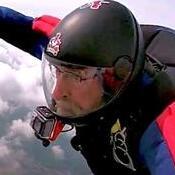IanHarrop 37
QuoteEvery video of a tandem side spin, (the donut of death), is pre-drogue deployment.
You are correct. However, my reference is to the corrective action and how our drogue bridle attachment works. Our drogue is loaded directly to the passengers’ hips bypassing the rig and the TI. The drogue directly suspends the passenger. If the passenger gets their legs out in front of them by bending at the waist (jack knifing) and the TI can't get their legs around the passenger’s legs and pull them back, then the TI must not arch. The TI has to put out the drogue at this point. The drogue due to the suspension will pull the passenger back into the proper orientation.
You preamble is appreciated and embraced. Thank you.
Next Subject: TSO requirements. I had planned to refer you to Manley Butler’s book about "How to get a TSO" so as to avoid a diatribe. However other posts subsequent to yours have indicated a desire for the long version. The simple answer is that there is no provision for Certification of an AAD component. TS-112 is a guide for manufacturers to approve the installation only, not for Certification of the device. Quite frankly it was a waste of time to write it as it serves no useful purpose except as cover.
Beginning of diatribe:
The TSO system is divided into several parts. “A” is for “Airframe” “B” is for Engines. The “C” in TSO-C-23x is in reference to the category of “Accessories” for the aircraft. A parachute system is considered an aircraft accessory. The number 23 is for parachutes on the list of accessories, basically emergency parachutes. However, the main parachute is considered primary and does not require certification while the life saving part is the reserve and harness and does require certification.
FAR Part 1 “Definitions” is where we begin. A parachute is defined as 6 major components with a bag or sleeve as optional. No mention of AADs, not that there couldn’t be. The TSO itself is simply a letter referring to an industry standard which defines the system and component qualification tests. In our case PIA TS-135.
TS-135 has no language for an AAD component as there is no such thing as an AAD defined as a part of a parachute system, and it probably should have. Therefore there is no standard or metric to which you may certify such a device. I invite you to generate some. The test need only to be performance type and durability tests and would not get into the inner working of the unit. Maybe it should have a POST (Power On Self Test) code and maybe a hot and cold soak to prove the environmental capability of the unit. Maybe an impact test to prove durability, etc.
Additionally, once the qualification tests are satisfactorily met you may apply to the FAA for authorization to identify the equipment as “Certificated”. That application is called the Data Package. It must include drawings adequate to reproduce the tested models as well as a statement of conformance to qualification tests and of the existence of an FAA approved QC plan and any and all manuals. Once approved this package become law and is difficult to change retroactively.
The problem at this point becomes conceptual. The first rule of AADs is that: “It must not interfere with the normal function of the reserve”. Any cutter is “potentially” capable of failing to cut and jamming the system. Therefore cutters are excluded. Some configurations are not as sensitive to this.
A bit of history: Back in the day, SSE was making the MK 2000. I had one and I decided to wear it when I moved to Deland. I was an I/E, and all that stuff and I believed in AADs as I still do. I had lost 2 of my best friends (team mates) to mid-airs. I was one of the moving forces to bring AADs to tandem. I wore it to set an example to younger jumpers. That is until the DZ owner came to me and said “Loose that Thing”. Obviously, I bucked at that but eventually I was beating a dead horse and I stopped using it. Its funny how 30 years ago a DZ owner was telling a customer that they should “loose that thing” (one which would not affect the reserve function) and today some are requiring them which might impair reserve function. How times change! Remember, it had a pyrotechnic fired “pusher”, big and clumsy. I previously had conversations with the folks at SSE about the potential use of cutters. They referred to the military experience on cutters in cargo parachutes which was not acceptable for human life protection. They said that the military would never accept cutters. Maybe it was PR.
Helmut (CYPRES) was from Germany and did not have the benefit of the military prejudice toward cutters so it was natural that he selected them for use. We all bought into his good work. Then along came another vendor who used a slightly different cutter which proved fatal. I never dreamed that this could happen but it did. It was at that time I came to realize the extent of the conceptual problem. A cutter, no matter how good, can fail the system. Therefore cutters are excluded from consideration
The AC-105-2c had language which could have been used to prosecute the rig manufacturer of Tandem rigs if the AAD failed. It is from that language that I requested my waiver. The more recent AC105-2d has clarified that language to mean that only the installation need be approved by the manufacturer not the AAD itself. I still have the waiver.
I am attaching a document/waiver, which was prepared for the purpose of demonstrated to DZ operators, who require AAD, that they are playing with fire by requiring same.
At this point in our development AADs must be a personal choice. Informed consent is the phrase which comes to mind. I dream of the day when we can have an AAD TSO’ed “which will not interfere with the normal function of”.
sundevil777 93
QuoteA cutter, no matter how good, can fail the system. Therefore cutters are excluded from consideration
Do you think there is no scenario where a non-cutter type of AAD can interfere with normal operation?
df8m1 19
I believe I can speak for everyone when I say thank you for taking the time to provide some incite regarding the AAD and TSO contradiction so to speak. I think that too little is known by the masses about the gear they are jumping, and knowledge is power.
Your history of participant in the process lends credibility to your position, which is part of the basis no doubt, for your decision to design and build your own containers. I am, in a similar fashion, going in that direction in regards to the cutters that will be used by my military AADs.
I received your PM and will respond directly, but also I wanted to post this, in the effort to tap into the wealth of opinions out there, which are valuable in evaluating an effort or concept such as a pusher vrs a cutter.
I will be manufacturing cutters for my own “in house” use, and it looks like I will be building some cutters for the Argus AADs that are in the field as well, once the cutter is approved by the manufacturers of course.
Aviacom has already done exactly what you are talking about, I have videos, but I will not post or share them with out permission from Aviacom first. I do not know if Aviacom has taken any action to legally protect their concept of an additional pin on the rip cord, being pushed out of the cutter housing or not. I can ask though.
Should there be no legal issues associated with producing the Aviacom style “pin pusher”, given that I will have the necessary parts and QC to build such a thing, if you were to generate a design speck, I would be interested in building them for you, if for nothing else, use with your tandem rigs, however, you will need to find an AAD to use to fire them, as I am pretty confident that Airtec and Vigil would not approve of the use of anything other than their cutters with their respective AADs.
Now on that note, I happen to know of an AAD that would support exactly what you are talking about,![]() and the details of which I will include in an e-mail to you in response to your PM. There may be an opportunity here to see if you are on to something here.
and the details of which I will include in an e-mail to you in response to your PM. There may be an opportunity here to see if you are on to something here.
QuoteDo you think there is no scenario where a non-cutter type of AAD can interfere with normal operation?
Only a fool would answer No. Never say never.
Having said that, let me say that I have not encountered one yet.
The Mk 2000 pusher worked well and had no reports of failures of this nature.
I would not have suspected the cutters would do what they did. My crystal ball has fogged.
Thus the reason for conceptual thinking.
Help me!
QuoteQuoteDo you think there is no scenario where a non-cutter type of AAD can interfere with normal operation?
Only a fool would answer No. Never say never.
Having said that, let me say that I have not encountered one yet.
The Mk 2000 pusher worked well and had no reports of failures of this nature.
I would not have suspected the cutters would do what they did. My crystal ball has fogged.
Thus the reason for conceptual thinking.
I'm a big fan of cutter on the bottom for the reasons already covered. My 05 Jav is setup that way, and honestly wish it had stayed there. Interested to hear what the PIA study digs up WRT differences in activation speed (if any) between the two locations.
flydog 0
I have a few more questions, but will wait to see what direction you have been thinking to bypass the obvious ones. Im sure you have thought on these as I am only asking after a cursory overview of the idea. I am not against the pusher just not sure it truly trumps a cutter. Thanks in advance.
QuoteAll logic would dictate this pin has to be above (or closer to the handle) than the other pins.
On a Racer I would put the AAD pin between the 2 existing pins with the butt or heal of the AAD pin flush with the bottom if the top pin. The AAD Pin would be orientated 180 opposite to the top regular pin. That puts the pusher between the 2 pins. I haven't looked at all instulations. However, I am confident it could be worked out using this new technique. I have seen and have video of the pusher configured for a 1 pin reserve and a 1 pin main. The AAD pin could be directly above or below the pin closes to the handle. Cable routing and protection is part of the mounting braketry. Don't know 'bout the Dual Hawks. But I like challenges.
sundevil777 93
QuoteQuoteDo you think there is no scenario where a non-cutter type of AAD can interfere with normal operation?
Only a fool would answer No. Never say never.
Having said that, let me say that I have not encountered one yet.
The Mk 2000 pusher worked well and had no reports of failures of this nature.
I would not have suspected the cutters would do what they did. My crystal ball has fogged.
Thus the reason for conceptual thinking.
Help me!
Yes, of course the potential for failure of a pin pusher/puller is very real. What advantage in terms of "not interfering with normal operation" do you think a puller/pusher would actually achieve? I think it would be worse, when compared to the type of cutter that we know has not failed.
One of the very important advantages of a cutter is that it is entirely independent of whether the normal pin mechanism can work - when the pin gets bent! As we know, the bent pin scenario is a very real situation that definitely has and will happen.
df8m1 19
If I look at the pin pusher ides as described and I have seen, I can see a scenario where the pin gets seized in the pusher housing, or the pusher gets twisted from a hit on exit, and the rip cord can’t be pulled, or the pusher fires and the pin gets cocked and is bent inside the pusher rendering the rip cord in-pullable.
A cutter that is designed based on 20 ish years of electronic AAD with cutters, taking into consideration some of their failures, and the configuration the different containers are arranged, would be a refinement of a proven method of pack opening. As I said previously, AAD manufacturers have relied on the cutter companies to supply them with a cutter, and they have industrial cutters that were designed to cut everything but 300 lb Spectra, while being packed tightly in a container with the loop being pulled several different ways. In the instance of the Argus cutters pinching loop, that failure can be reproduced, so, I will have a comparison test to see how my design performs in the same configuration that the Argus cutter pinches.
IMOP, a properly designed cutter has “head room” designed into it, and what I mean by that is, all the AAD manufacturers require a min closing loop tension, this tension is to help the cutter cut the loop, or for the loop to overcome any pinching created by the cutter during or after the cut. One of my design objectives is a no tension requirement, the cutter should be able to cleanly cut the loop with ½ the power charge, and no tension, while arranged in the failure mode configuration.
There is an advantage of designing something with some history to reflect on. The pusher concept is different, and there is a reason why there are more than one rig manufacturer, different people like different things. It may be attractive to some as a cutter is attractive to others. Heck, there are still experienced jumpers that use a spring loaded main pilot chute lol.
The failures of the past can provide direction in the future. The proof is in the pudding… tell you what…. Ill build my cutter, and will even build you some pushers if the details can be worked out, and, may the best win lol.






First let me say that I know exactly to whom I am chatting with, and I mean no disrespect with my approach to my thinking, to the contrary, you are one of the few who can possibly provides some incite. Now that being said;
Can you elaborate a little more on that. Again, this is just my understanding, but as such, it is that the TSO tests are to validate that a container / harness system (regardless of its design), functions with in standardized specs. The design of the container can be what ever as long as it passes the tests, and it is the configuration of the rig that is awarded the TSO, so as a result, several different size container and canopy combinations can be produced under the umbrella of the original TSO. Now I may be totally wet, but that is my understanding.
Now, continuing on that train of thought, given that the concern is if an AAD will affect the ability of the reserve to operate properly (will the cutter affect the pack opening), I am thinking, why not pick the best AAD, (as odds are the end user will be putting one in) and put the rig through the TSO tests and see if it still passes. If it does, then the combination of the rig and AAD would be harmonious with the TSO.
Now, just thinking out loud, is it the situation where the reserve its self is TSOed, the container design using the TSOed reserve is TSOed, and it is that the AAD its self is not TSOed that is the concern, rather than will it interfere with the operation with the container?
I would think that if the US required AADs, then to get a TSO, a rig would have to be tested with an AAD packed in it, no?
I get that a rig manufacturer does not want to be liable for a cutter locking a rig shut, nor does an AAD manufacture want to be liable for a container / canopy combination that is built under the umbrella of a TSO, when the actual rig would not pass the same TSO if its life depended on it.
My approach with my cutter is to try to work with the container manufacturers in an effort to produce a cutter that the manufacturers are comfortable with. I am also good with the thinking that AADs need to meet a standard of some kind.
PIA TS-112 provides a guideline for testing. I don't know what the impact is on TSO. Looking forward to John explaining it.